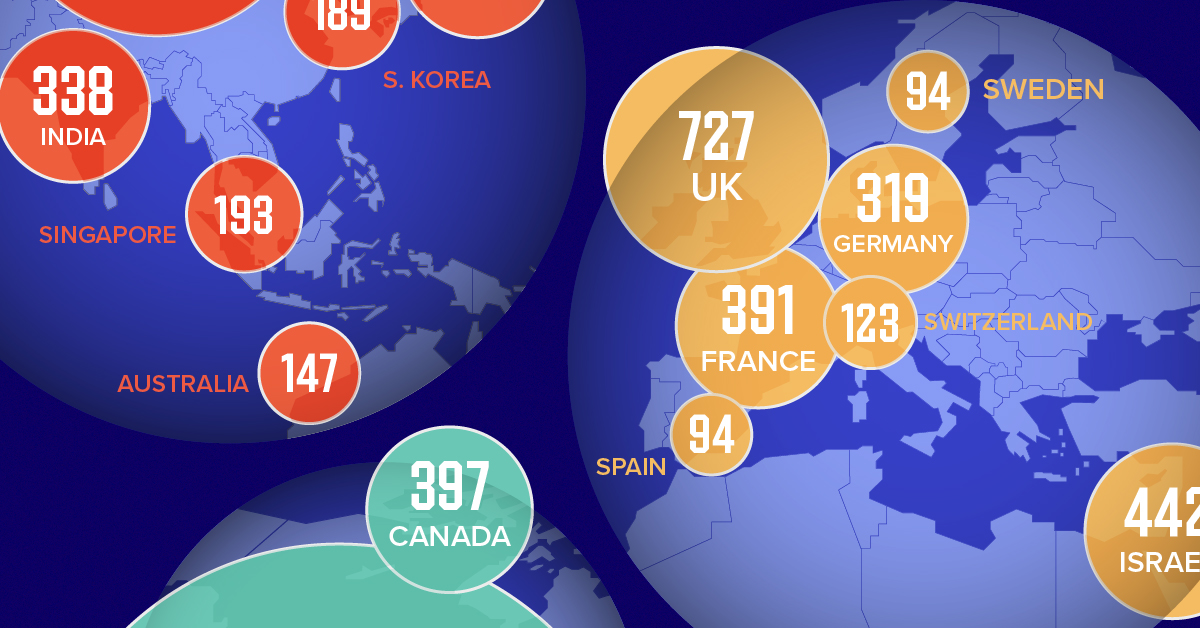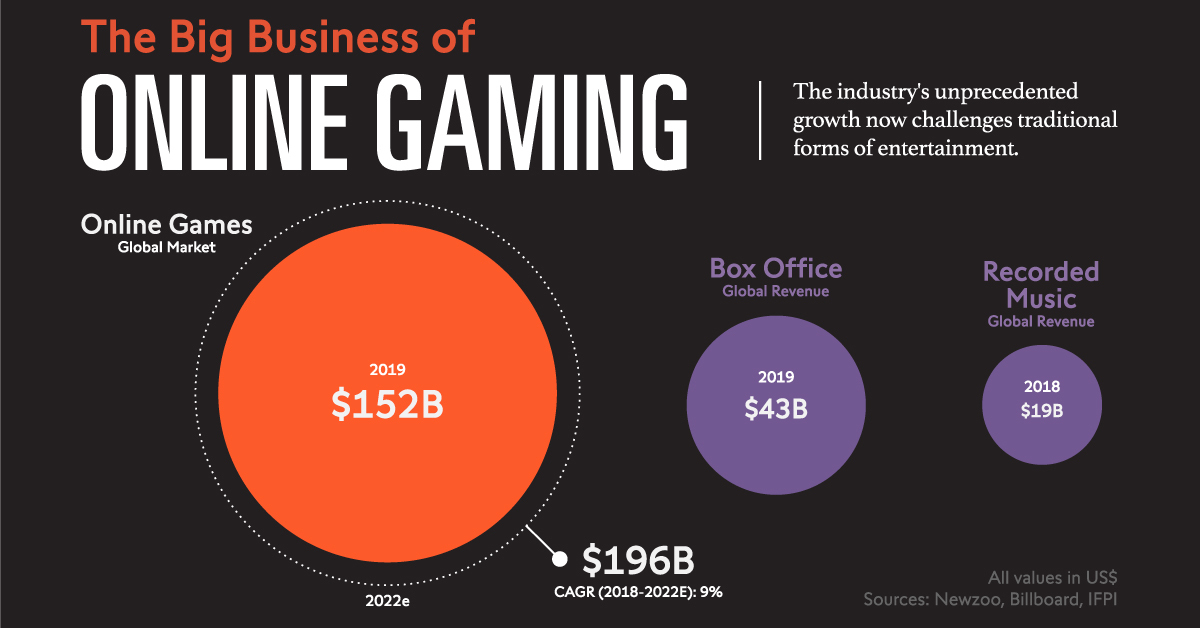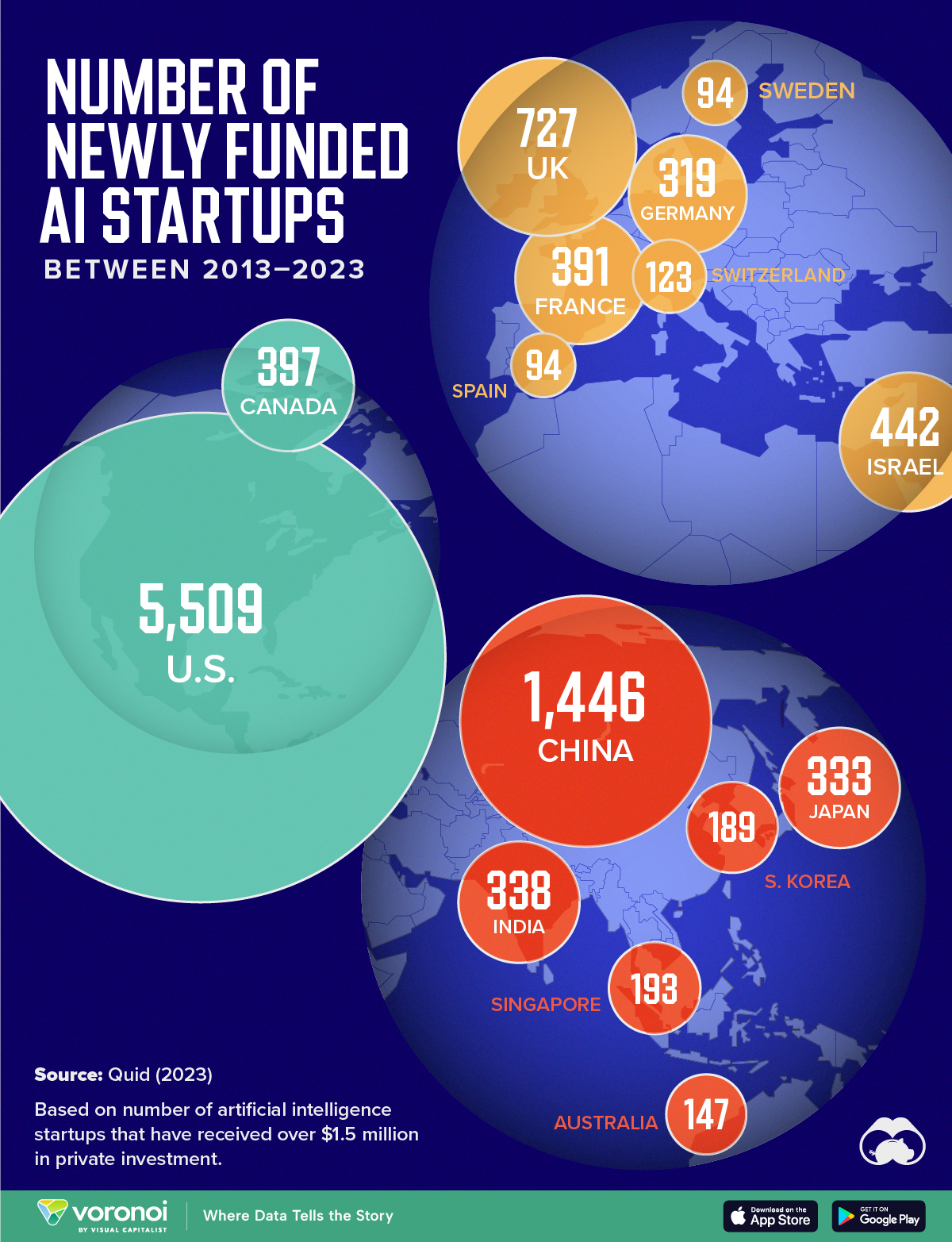Technology
Online Gaming: The Rise of a Multi-Billion Dollar Industry

Online Gaming: The Rise of a Multi-Billion Dollar Industry
From tabletops to virtual reality, how we play games is changing with the times.
In just a few short decades, the world of online gaming has exploded in popularity. Estimated to reach $196 billion in revenue by 2022, it is now considered to be one of the fastest growing industries on the planet.
The infographic above explores the humble beginnings of the online gaming market and dives into the technological possibilities driving its future.
The Birth of Online Gaming
Although video game prototypes were created by scientists as early as the 1950s, the very first gaming console was not introduced to consumers until the ‘70s. Subsequently, use of online games began to proliferate in the ‘90s as a result of widespread internet adoption.
- 1990s: Online gaming rapidly gains popularity due to the increasing availability of the internet
- 2003: Digital storefront Steam launches, allowing gamers to buy and review games online
- 2004: World of Warcraft launches, the first massively multiplayer online (MMO) to eclipse more than 10 million active subscriptions
- 2007: Online gaming starts shifting to mobile
- 2009: Minecraft launches and becomes one of the best selling video games in history with 176 million copies sold
- 2009: Apple announces In-app Purchase feature for iPhone apps
- 2015: 1.5 billion gamers around the world
- 2016: Augmented reality game Pokémon Go is launched, generating the most revenue grossed by any mobile game in its first month.
- 2019: Google releases Stadia, a cloud gaming service that allows gamers to play without a console
It is clear that technological innovation plays a huge role in fueling the evolution of online gaming, but there are also several other factors at play.
The Components of Online Gaming
In the world of gaming, there is often confusion between commonly used terms such as “online gaming” and “esports”—when in fact esports is just one segment that sits within the enormous online gaming ecosystem:
- Distributors and Retailers: Platforms that distribute and sell games
- Streaming Services: Services that allow users to livestream games
- Hardware Developers: Companies that build the electronic infrastructure required to play games
- Gaming Arenas: Venues that host gaming events
- Esports: Organized, multiplayer video game competitions, typically between professional players
- Software Developers: Develop applications that allow users to do specific tasks
- Game Publishers: Companies that finance and distribute games
- Game Developers: Studios that develop games
This ecosystem creates dozens of revenue streams for the industry as a whole. For every one of these channels, the shift to mobile gaming presents significant opportunities for growth.
Mobile: The Future of Gaming
Mobile is the largest gaming platform, producing $68.5 billion in revenue in 2019—45% of the total market that also includes PC and tablet gaming.
Although still a relatively new segment of the industry, mobile gaming has developed at an astonishing rate, with 2.4 billion people playing games on mobile in 2019. Part of mobile’s breakneck growth can be attributed to an innovative and seamless user experience which relies on engaging features such as in-app purchases and loyalty rewards.
With the 5G era quickly descending upon us, these pocket-sized game consoles could transform online gaming, and make the industry even more exciting.
Towards a New Age of Entertainment
As the number of players continues to grow, it is clear that the technological possibilities of online gaming are endless. Some are already beginning to take shape:
Virtual Reality
With industry leaders such as Oculus and Valve announcing cheaper headset options, blurring the lines between fantasy and reality is becoming more accessible for mass markets, and the pace could pick up further in 2020.
Cloud Gaming
Cloud gaming takes advantage of faster, more reliable internet connections by giving gamers the ability to stream games rather than playing on a console.
Real-time Personalization
In the future, games could automatically generate game content that is customized to fit each player’s personality and playstyle, based on their player data.
As these technologies develop, they alter the way users experience games, and provide new opportunities for brands and advertisers to tap into enhanced viewer engagement.
Many industry players will thrive in this new environment, while others will fall by the wayside. Who will emerge victorious, and lead us into the future of entertainment?
Digital Transformation
Mapped: The Number of AI Startups By Country
Over the past decade, thousands of AI startups have been funded worldwide. See which countries are leading the charge in this map graphic.

Mapped: The Number of AI Startups By Country
This was originally posted on our Voronoi app. Download the app for free on iOS or Android and discover incredible data-driven charts from a variety of trusted sources.
Amidst the recent expansion of artificial intelligence (AI), we’ve visualized data from Quid (accessed via Stanford’s 2024 AI Index Report) to highlight the top 15 countries which have seen the most AI startup activity over the past decade.
The figures in this graphic represent the number of newly funded AI startups within that country, in the time period of 2013 to 2023. Only companies that received over $1.5 million in private investment were considered.
Data and Highlights
The following table lists all of the numbers featured in the above graphic.
| Rank | Geographic area | Number of newly funded AI startups (2013-2023) |
|---|---|---|
| 1 | 🇺🇸 United States | 5,509 |
| 2 | 🇨🇳 China | 1,446 |
| 3 | 🇬🇧 United Kingdom | 727 |
| 4 | 🇮🇱 Israel | 442 |
| 5 | 🇨🇦 Canada | 397 |
| 6 | 🇫🇷 France | 391 |
| 7 | 🇮🇳 India | 338 |
| 8 | 🇯🇵 Japan | 333 |
| 9 | 🇩🇪 Germany | 319 |
| 10 | 🇸🇬 Singapore | 193 |
| 11 | 🇰🇷 South Korea | 189 |
| 12 | 🇦🇺 Australia | 147 |
| 13 | 🇨🇭 Switzerland | 123 |
| 14 | 🇸🇪 Sweden | 94 |
| 15 | 🇪🇸 Spain | 94 |
From this data, we can see that the U.S., China, and UK have established themselves as major hotbeds for AI innovation.
In terms of funding, the U.S. is massively ahead, with private AI investment totaling $335 billion between 2013 to 2023. AI startups in China raised $104 billion over the same timeframe, while those in the UK raised $22 billion.
Further analysis reveals that the U.S. is widening this gap even more. In 2023, for example, private investment in the U.S. grew by 22% from 2022 levels. Meanwhile, investment fell in China (-44%) and the UK (-14.1%) over the same time span.
Where is All This Money Flowing To?
Quid also breaks down total private AI investment by focus area, providing insight into which sectors are receiving the most funding.
| Focus Area | Global Investment in 2023 (USD billions) |
|---|---|
| 🤖 AI infrastructure, research, and governance | $18.3 |
| 🗣️ Natural language processing | $8.1 |
| 📊 Data management | $5.5 |
| ⚕️ Healthcare | $4.2 |
| 🚗 Autonomous vehicles | $2.7 |
| 💰 Fintech | $2.1 |
| ⚛️ Quantum computing | $2.0 |
| 🔌 Semiconductor | $1.7 |
| ⚡ Energy, oil, and gas | $1.5 |
| 🎨 Creative content | $1.3 |
| 📚 Education | $1.2 |
| 📈 Marketing | $1.1 |
| 🛸 Drones | $1.0 |
| 🔒 Cybersecurity | $0.9 |
| 🏭 Manufacturing | $0.9 |
| 🛒 Retail | $0.7 |
| 🕶️ AR/VR | $0.7 |
| 🛡️ Insurtech | $0.6 |
| 🎬 Entertainment | $0.5 |
| 💼 VC | $0.5 |
| 🌾 Agritech | $0.5 |
| ⚖️ Legal tech | $0.4 |
| 👤 Facial recognition | $0.3 |
| 🌐 Geospatial | $0.2 |
| 💪 Fitness and wellness | $0.2 |
Attracting the most money is AI infrastructure, research, and governance, which refers to startups that are building AI applications (like OpenAI’s ChatGPT).
The second biggest focus area is natural language processing (NLP), which is a type of AI that enables computers to understand and interpret human language. This technology has numerous use cases for businesses, particularly in financial services, where NLP can power customer support chatbots and automated wealth advisors.
With $8 billion invested into NLP-focused startups during 2023, investors appear keenly aware of this technology’s transformative potential.
Learn More About AI From Visual Capitalist
If you enjoyed this graphic, be sure to check out Visualizing AI Patents by Country.
-

 Mining6 days ago
Mining6 days agoVisualizing Global Gold Production in 2023
-

 AI2 weeks ago
AI2 weeks agoVisualizing AI Patents by Country
-

 Markets2 weeks ago
Markets2 weeks agoEconomic Growth Forecasts for G7 and BRICS Countries in 2024
-

 Wealth2 weeks ago
Wealth2 weeks agoCharted: Which City Has the Most Billionaires in 2024?
-

 Technology2 weeks ago
Technology2 weeks agoAll of the Grants Given by the U.S. CHIPS Act
-

 Green2 weeks ago
Green2 weeks agoThe Carbon Footprint of Major Travel Methods
-

 United States1 week ago
United States1 week agoVisualizing the Most Common Pets in the U.S.
-

 Culture1 week ago
Culture1 week agoThe World’s Top Media Franchises by All-Time Revenue











